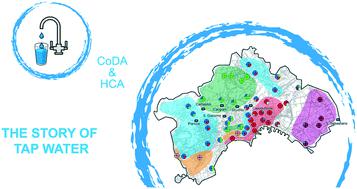当前位置:
X-MOL 学术
›
Environ. Sci.: Water Res. Technol.
›
论文详情
Our official English website, www.x-mol.net, welcomes your
feedback! (Note: you will need to create a separate account there.)
Coupling compositional data analysis (CoDA) with hierarchical cluster analysis (HCA) for preliminary understanding of the dynamics of a complex water distribution system: the Naples (South Italy) case study
Environmental Science: Water Research & Technology ( IF 3.5 ) Pub Date : 2021-4-9 , DOI: 10.1039/d0ew01123a Pooria Ebrahimi 1 , Stefano Albanese 1 , Leopoldo Esposito 2 , Daniela Zuzolo 3 , Domenico Cicchella 3
Environmental Science: Water Research & Technology ( IF 3.5 ) Pub Date : 2021-4-9 , DOI: 10.1039/d0ew01123a Pooria Ebrahimi 1 , Stefano Albanese 1 , Leopoldo Esposito 2 , Daniela Zuzolo 3 , Domenico Cicchella 3
Affiliation

|
Providing safe tap water has been a global concern. Water scarcity, the ever-increasing water demand, temporal variation of water consumption, aging urban water infrastructure and anthropogenic pressure on the water resources are the greatest challenges in effective water supply. In the present article, the waters exploited to be introduced in a water distribution system (i.e. input water) and tap waters are collected for determination of metal(loid)s, ions and physicochemical parameters. Seasonal variation is observed in the chemistry of the input waters. Further, the annual total dissolved solids (TDS) of the tap waters range from 200 to 1000 mg l−1 which stresses the importance of interconnections between urban water reservoirs for mixing different water types and adjusting water quality. It is complicated in populated cities like Naples with an old water distribution network, which also challenges setting up hydraulic and water quality models. The preliminary data visualization indicates the different chemical characteristics of some samples that are supposed to receive water from the same source. This might explain the difficulties in understanding the network layout in Naples. Thus, the compositional nature of chemical data was considered in hierarchical cluster analysis (HCA) to seasonally study water transfer between urban water reservoirs and define the source of tap water in each city area. The proposed method can preliminarily divide the pipe network into unique clusters and provide an overview of the relationships between different components when representative models cannot be set up due to limited information about network characteristics. Hence, advanced water distribution simulation and management is encouraged.
中文翻译:

将组成数据分析(CoDA)与层次聚类分析(HCA)结合使用,以初步了解复杂的水分配系统的动力学:那不勒斯(意大利南部)案例研究
提供安全的自来水已成为全球关注的问题。缺水,不断增长的需水量,耗水量的时间变化,城市供水基础设施老化以及人为的水资源压力是有效供水的最大挑战。在本文中,利用被引入水分配系统中的水(即输入水)和自来水进行收集,以确定金属(金属),离子和理化参数。在输入水的化学成分中观察到季节性变化。此外,自来水的年总溶解固体(TDS)范围为200至1000 mg l -1这强调了城市水库之间相互连接对于混合不同类型的水和调节水质的重要性。在那不勒斯等人口稠密的城市,旧的配水网络使情况变得复杂,这也给建立水力和水质模型带来了挑战。初步数据可视化表明应该从同一来源接收水的某些样品的不同化学特性。这可能解释了在那不勒斯了解网络布局时遇到的困难。因此,在层次聚类分析(HCA)中考虑了化学数据的组成性质,以季节性研究城市水库之间的水转移并定义每个城市地区的自来水来源。当由于关于网络特性的有限信息而无法建立代表性模型时,所提出的方法可以预先将管网划分为唯一的群集,并概述不同组件之间的关系。因此,鼓励进行先进的水分配模拟和管理。
更新日期:2021-04-29
中文翻译:

将组成数据分析(CoDA)与层次聚类分析(HCA)结合使用,以初步了解复杂的水分配系统的动力学:那不勒斯(意大利南部)案例研究
提供安全的自来水已成为全球关注的问题。缺水,不断增长的需水量,耗水量的时间变化,城市供水基础设施老化以及人为的水资源压力是有效供水的最大挑战。在本文中,利用被引入水分配系统中的水(即输入水)和自来水进行收集,以确定金属(金属),离子和理化参数。在输入水的化学成分中观察到季节性变化。此外,自来水的年总溶解固体(TDS)范围为200至1000 mg l -1这强调了城市水库之间相互连接对于混合不同类型的水和调节水质的重要性。在那不勒斯等人口稠密的城市,旧的配水网络使情况变得复杂,这也给建立水力和水质模型带来了挑战。初步数据可视化表明应该从同一来源接收水的某些样品的不同化学特性。这可能解释了在那不勒斯了解网络布局时遇到的困难。因此,在层次聚类分析(HCA)中考虑了化学数据的组成性质,以季节性研究城市水库之间的水转移并定义每个城市地区的自来水来源。当由于关于网络特性的有限信息而无法建立代表性模型时,所提出的方法可以预先将管网划分为唯一的群集,并概述不同组件之间的关系。因此,鼓励进行先进的水分配模拟和管理。











































 京公网安备 11010802027423号
京公网安备 11010802027423号